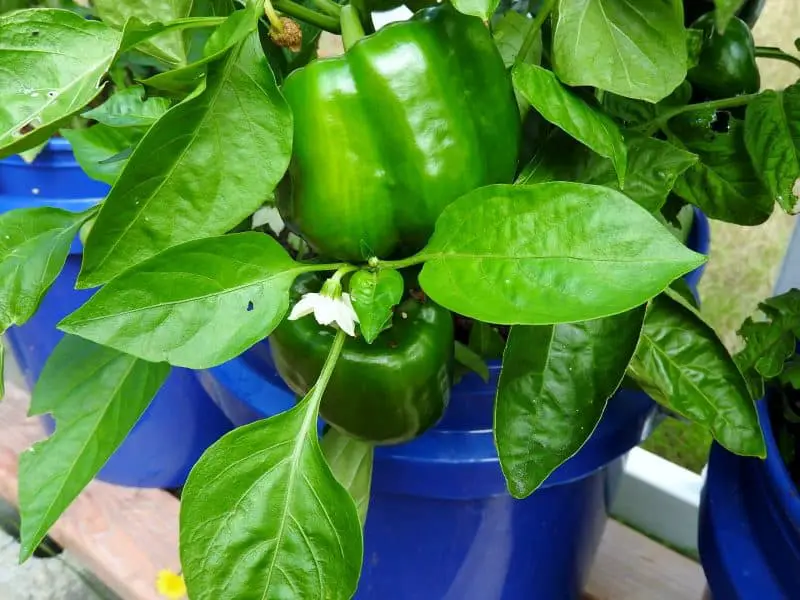This post contains affiliate links. If you buy something from one of our links we may earn a commission. Thanks
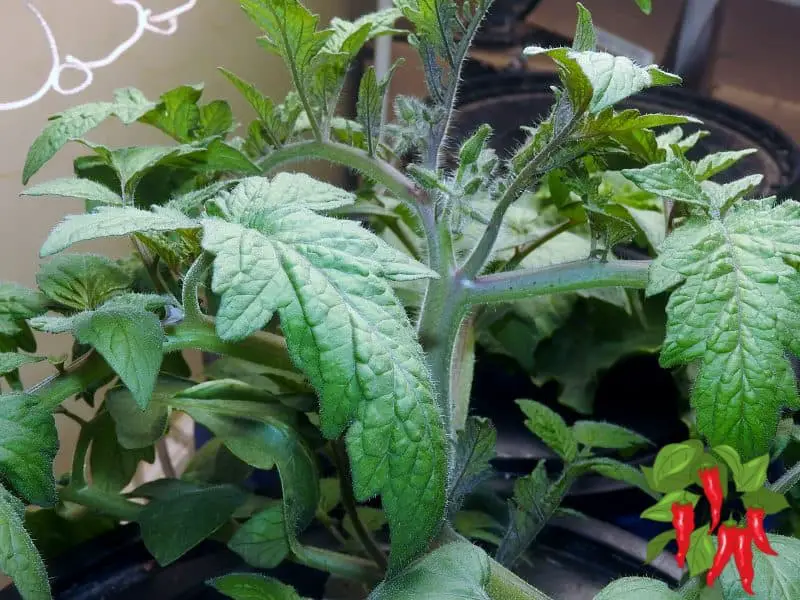
Can you grow DWC Tomatoes? The answer is yes. Learn about deep water culture and how to grow your own DWC tomatoes.
Discover the ease and rewards of growing DWC tomatoes! This guide offers practical tips on setting up a deep water culture system for thriving tomato plants.
We will also cover some other methods to grow tomatoes if you decide DWC is not for you.
Deep Water Culture Key Takeaways:
- DWC or deep water culture is a hydroponic growing method that does not use soil.
- Roots grow in oxygenated water instead. It is suitable for large plants like tomatoes.
What Do I Need To Grow DWC Tomatoes?
Are you curious about DWC tomatoes? This guide takes you through the exciting journey of growing tomatoes using deep water culture (DWC).
Ideal for both beginners and seasoned gardeners, you’ll find step-by-step instructions, practical tips, and insights to help you succeed in growing lush, healthy DWC tomatoes.
Growing DWC tomatoes indoors does not require a lot of equipment. It is very easy to set up too. I think it is the best hydroponic system for large plants.
You will need the following:
• A 5-gallon bucket and lid.
• A six-inch net pot
• Some hydroton
• An air pump and airstones
• A grow light
• A tomato plant or seeds
• Nutrient solution
Here’s How To Grow DWC Tomatoes
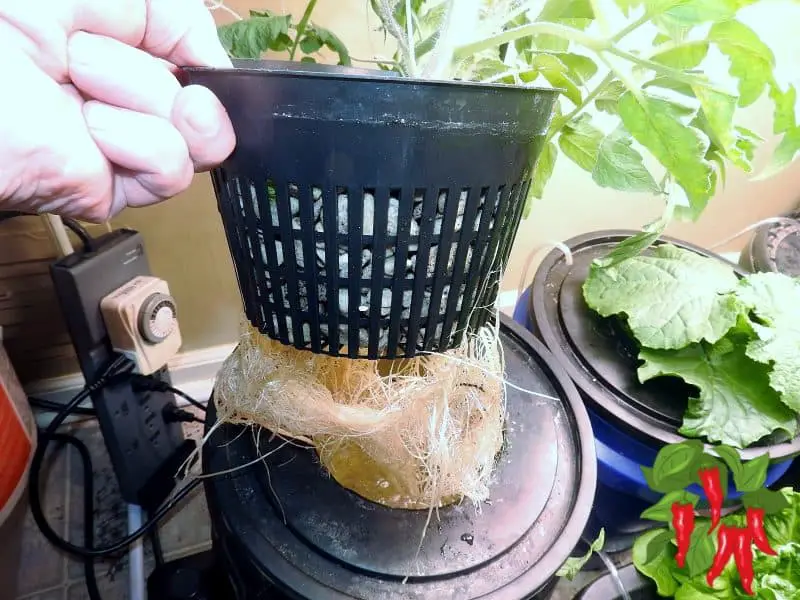
You will need to cut a hole in the lid to fit the 6-inch net pot in. You can buy a bucket lid with the net pot built into it.
You do not need anything larger than a 6-inch net pot because the roots will grow inside the bucket and not in the pot.
Either buy a tomato transplant or start one from seed. If you buy one you will want to gently wash away as much soil as you can from the roots.
Whether you grow from plants or seeds I recommend you get a bush variety, often they are called determinate varieties. This will give you a shorter plant and make it easier to grow.
You will want to place the plant in your net pot and fill in all around it with hydroton or another inert growing medium.
You will want to drill a 1/4 inch hole in the lid for your airline and attach the end in the bucket to your airstone or airstones. It’s ok to use more than one.
Fill the bucket up with water and add nutrients at half the manufacturer’s recommended amount.
The water level should be about an inch above the bottom of your net pot. We will let it drop a few inches over time.
Then throughout the grow you will want to keep the bucket water level a few inches below your net pot.
The roots that grow in this space are called air roots and they help the plant get additional oxygen.
Plug in your air pump and make sure you have bubbles in your bucket. DWC like this is also called bubble buckets.
You may need to hand water your tomato seedlings from the top for the first few days until roots are established.
Pat yourself on the back. You are now growing DWC tomatoes.
Remember tomatoes are a plant that needs a lot of light. Unless you are growing them on a sunny balcony you will need to keep them under a LED grow light.
DWC System Tips
Monitor Nutrient Levels
You will want to monitor your nutrient levels daily in this type of system. You should be using hydroponic nutrients in a deep water culture system.
Organic nutrients have no place in water culture systems. They can feed bacteria you don’t want to grow inside your nutrient reservoir.
Monitor your nutrient mixture. It can be measured as electrical conductivity or EC. It can also be measured in ppms with a TDS meter.
Pick one and stick with it EC is more universal and TDS is a bit more popular in the U.S.
Monitor pH Levels
You need to monitor ph levels. 5.8 is considered the sweet spot. If it gets too high or low nutrient availability can suffer. You can have a nutrient lockout.
Even though the nutrients are there the plant roots can’t absorb them if the ph is way off. Keep your ph between 5.5-6 for best results.
Monitor Water Temperature
The most important thing is to monitor your water temperature. 68 degrees is considered ideal. Water temperature affects oxygen levels. Cold water holds more than warm water.
You can go down a bit but if it’s below 65° cold water in the root zone could shock your plants. Also above 72°, you run the risk of getting Pythium root rot. This is the main reason these systems fail.
Make sure your water pump does not get clogged with roots or other debris if you are using a pump to recirculate nutrients. Check the oxygen levels too. You want lots of bubbles and airstones can become less efficient over time.
Remember tomatoes need a lot of light. Make sure you have LED grow lights if light levels are low where your plants are. Unless you are growing outdoors using grow lights is a good idea. They can improve growth rates dramatically.
If you follow these growth tips you will get high yields of fresh tomatoes with a simple traditional dwc system.
Read more about my DWC apartment kitchen garden here: Apartment Kitchen Garden – Growing A Hydroponic Garden In An Apartment (indoorvegetablegrower.com)
Determinate Vs Indeterminate Tomatoes
There are many different ways tomato plants grow. In the greenhouse, most growers will choose indeterminate tomatoes because they grow and bear continuously.
Determinate varieties are more bush-like and very popular in outdoor gardens because they are easier to train and yield sooner.
The harvest will also be more uniform with most tomatoes ready at about the same time.
When tomatoes are field grown these determinate plants allow for machine harvest. In the garden, they allow peak harvests before frost.
One of the classifications you will often see on the label of a tomato plant or on a packet of tomato seeds is “determinate” or “indeterminate.” These terms refer to the growth habit of the tomato plants. They essentially mean bush or vining tomatoes, respectively. https://www.thespruce.com/indeterminate-tomato-variety-1403423
Determinate Vs Indeterminate Tomatoes What To Grow
I think determinate tomato varieties are the best tomatoes for hydroponics and for growing indoors. Although indeterminate varieties can be grown as hydroponic tomatoes training them can be difficult.
Determinate tomatoes should not be pruned as it would reduce yield. But indeterminate tomatoes can benefit from pruning because they can overproduce more than they can ripen.
Also because we will be growing our tomatoes indoors under lights, bush varieties will be much easier to manage and grow.
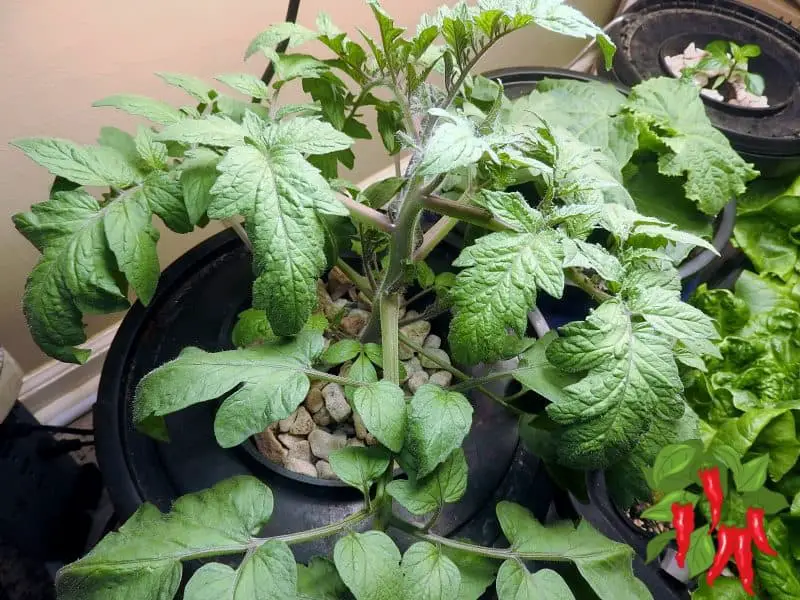
What Hydroponic System Is Best For Tomatoes?
Most tomatoes are large plants with a large root system. Indeterminate varieties can grow quite tall with many stems.
Because of this they are often staked or grown in tomato cages or under a trellis net to support their branches.
DWC is probably the best and most productive hydroponic system for growing tomatoes. It can allow a large root system to grow and be fed directly.
With a good support system like a trellis or cage, they can produce many pounds of fruit on a continual basis.
Kratky Tomatoes Indoors?
The Kratky system is a passive hydroponic system and a form of DWC that does not use air stones. Add an air stone and grow dwc lettuce instead.
You will be glad you did the beauty of the Kratky system is it works in the third world where there might not be electricity. But if you have it use it.
Typically it is used for small plants like lettuce or other fast-growing greens. It is only filled once at the start of the grow.
However, the developer of this system was able to grow tomatoes in his Kratky system by using a garbage can for a bucket.
So it can be done if you don’t mind having a trash can in your house. You would still use a tomato plant in a 6-inch net pot with hydroton inside inserted into the lid.
Other Ways To Grow Hydroponic Tomatoes Indoors
Good news! If you are limited in space or don’t want to buy a LED grow light you can still grow hydroponic tomatoes indoors.
Have you heard of an AeroGarden? AeroGarden worth buying? An Honest Review Of The Aerogarden Harvest (indoorvegetablegrower.com)
The AeroGarden is a small hydroponic unit that can be fit almost anywhere. It comes with its own grow light too.
You can grow tomatoes, peppers, lettuce, and herbs in it. You can’t grow full-sized tomatoes in it because of its smaller size.
But if you like cherry or patio tomatoes you can grow them in an AeroGarden.
GroBuckets For Indoor Tomatoes
If you want to grow tomatoes indoors but want a more conventional way to grow tomatoes, peppers, or other larger plants with soil or coco coir you can use 5-gallon GroBuckets with coco coir or soil.
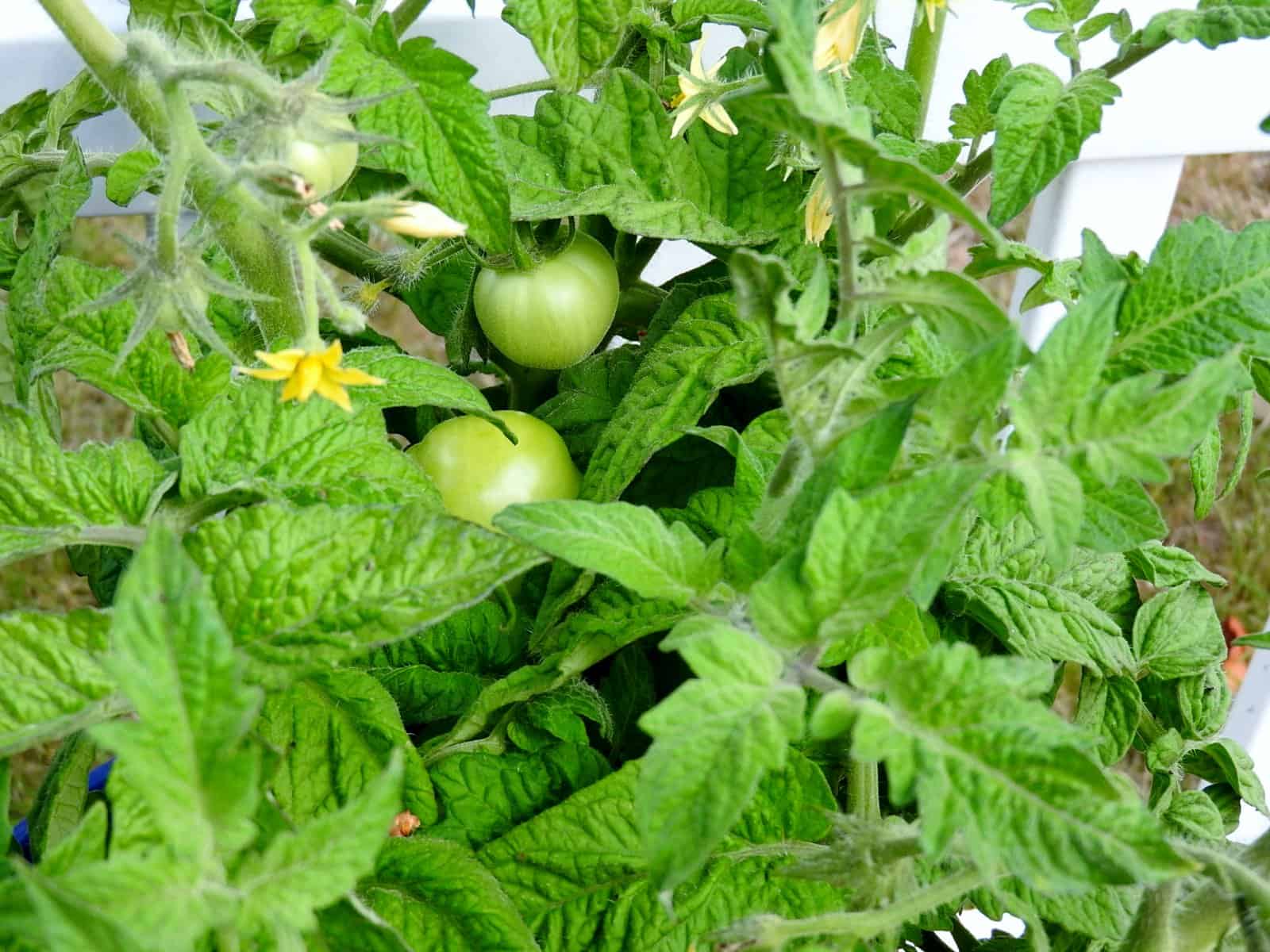
GroBuckets can be used indoors or out and filled with potting soil or coco coir. They are also called a SIP or sub-irrigated planter. Read more: GroBucket Garden Kit How To Easily Grow Great Veggies In 2022 (indoorvegetablegrower.com)
Hempy Buckets For Tomatoes
The hempy bucket is very similar to the GroBucket. Generally, they are a passive hydroponic system that usually uses perlite but it can also use a coco/perlite mix. Read more about hempy buckets here: What Is A Hempy Bucket? [Best Easy Hydro System For Beginners] (indoorvegetablegrower.com)
How Long Can A Hydroponic Tomato Plant Live?
Tomatoes (Solanum Lycopersicon) are perennials in their natural environment although in most areas they are grown as annuals.
They naturally grow as a sprawling vines and can reach a length of 10 feet or more.
However shorter and bush varieties have been developed. Outdoors cold temperatures will eventually kill them.
Also, you may be surprised to know that tomatoes are actually a fruit and not a vegetable. They are actually large berries.
When you grow tomatoes indoors they can live for up to 2 years provided the roots remain healthy but 6 months would probably be more realistic.
More info on tomatoes: https://www.britannica.com/plant/tomato
Some Thoughts On DWC Tomatoes
If you want to grow tomatoes they are a large plant with a large root system. They will grow their best in a DWC hydroponic system.
Deep water culture provides much faster growth than soil systems and crops will mature sooner too.
To really succeed with DWC tomatoes you need to keep your water temperatures on the cool side. Warm temperatures can promote root rot.
68 degrees is considered optimal because as temperatures rise oxygenation decreases.
Above 72 degrees you are in the danger zone for Phytophthora root rot. Phytophthora – Wikipedia
But there are ways to prevent it by using bleach or hydrogen peroxide as an additive. More info at https://www.indoorvegetablegrower.com/what-is-a-hydroponic-reservoir/
Tomatoes are self-pollinating but there are no bees in your apartment (hopefully) so you may want to hand-pollinate your tomatoes.
You can do this once the flowers open by going from one flower to another while touching the pistils with a small brush.
Some growers even use an electric toothbrush for this.
Did you know tomatoes are actually a fruit? https://www.indoorvegetablegrower.com/are-you-growing-fruits-or-vegetables/
Growing Determinate Tomatoes How to Prune And Train Them
Here is a video showing my DWC determinate tomato plant put in a trellis.
Determinate varieties bear the bulk of their crop all at once so they will need support.
I also explain that determinate tomatoes should not be pruned like indeterminate ones. They are very different plants.
FAQS
Have questions about growing DWC tomatoes? Here are some frequently asked questions to help you understand and navigate the process of setting up and maintaining a successful deep water culture tomato garden.
Q: What is deep water culture (DWC)?
A: Deep water culture is a hydroponic method where plant roots are suspended in oxygen-rich, nutrient-filled water, promoting faster growth and higher yields.
Q: Can I grow any type of tomato in a DWC system?
A: Yes, but determinate (bush) varieties are often recommended for DWC as they are easier to manage indoors and have a more controlled growth habit.
Q: How often should I check the nutrient levels in my DWC system?
A: It’s advisable to monitor nutrient levels daily to ensure optimal growth conditions for your DWC tomatoes.
Q: What is the ideal pH level for DWC tomatoes?
A: The ideal pH level for DWC tomatoes is around 5.5 to 6.0, with 5.8 being the sweet spot for maximum nutrient uptake.
Q: Can DWC tomatoes be grown indoors?
A: Yes, DWC tomatoes can thrive indoors with adequate grow lights, such as LED lights, to compensate for the lack of natural sunlight.
Growing DWC Tomatoes Conclusion
Growing DWC tomatoes is an efficient, rewarding way to garden. It offers faster growth and higher yields compared to traditional soil gardening.
Embrace the world of hydroponics and enjoy the fresh, flavorful harvest from your DWC tomato plants.
By understanding and implementing the deep water culture system, you’ll enjoy faster growth and higher yields.
Growing DWC Tomatoes Key Takeaways:
- Growing DWC tomatoes involves setting up a deep water culture system where the roots of the tomato plant are submerged in nutrient-rich, oxygenated water.
- This soilless method accelerates growth, increases yield, and is suitable for both indoor and outdoor gardening.
Here are some takeaways to enhance your DWC tomato gardening experience:
- Nutrient Management: Consistently monitor and adjust nutrient levels to ensure your tomatoes receive the right balance for optimal growth.
- Lighting Solutions: If you’re growing indoors, explore different types of grow lights, such as LED, to provide sufficient light for your plants.
- Temperature Control: Maintaining the ideal water temperature is crucial. Implement ways to keep the water at the optimal temperature to prevent issues like root rot.
- pH Level Monitoring: Regularly check and adjust the pH levels to ensure nutrient availability and uptake.
- Pest and Disease Management: Learn about common pests and diseases that might affect DWC tomatoes and how to prevent or treat them effectively.
- Pruning Techniques: Understand the specific pruning needs of determinate and indeterminate tomato varieties to maximize yield and health.
- Pollination Tips: As tomatoes are self-pollinating, discover ways to assist this process indoors, such as using a small brush or an electric toothbrush.
- Harvesting Strategies: Learn when and how to harvest your tomatoes for the best flavor and longevity.
By integrating these aspects into your DWC tomato gardening, you’ll not only enhance your yields but also gain a deeper understanding and appreciation of the hydroponic growing process.
Enjoy the journey of cultivating your DWC tomatoes, and savor the taste of your home-grown produce!


